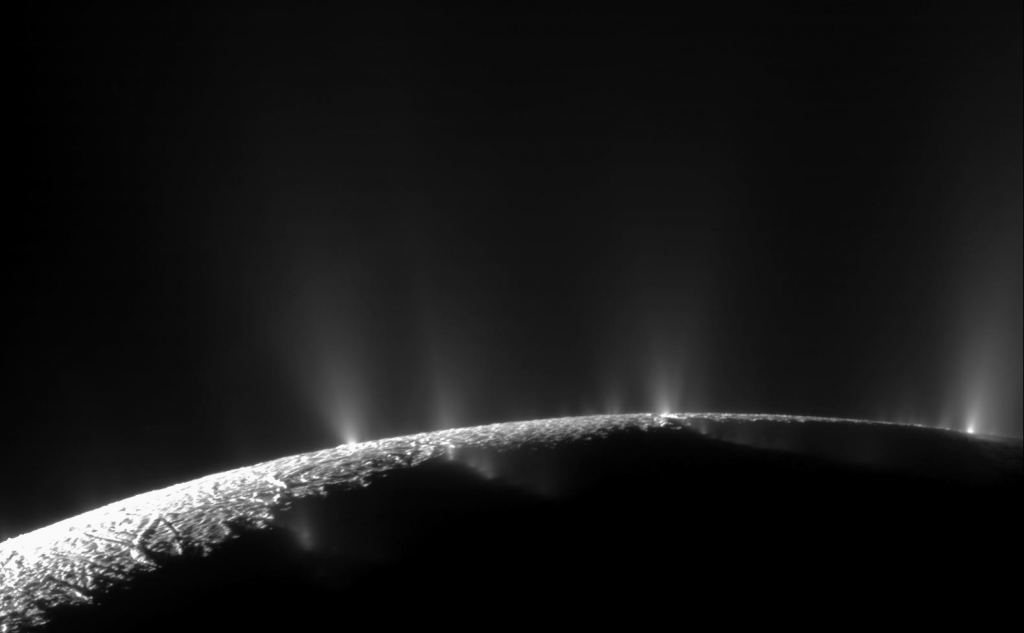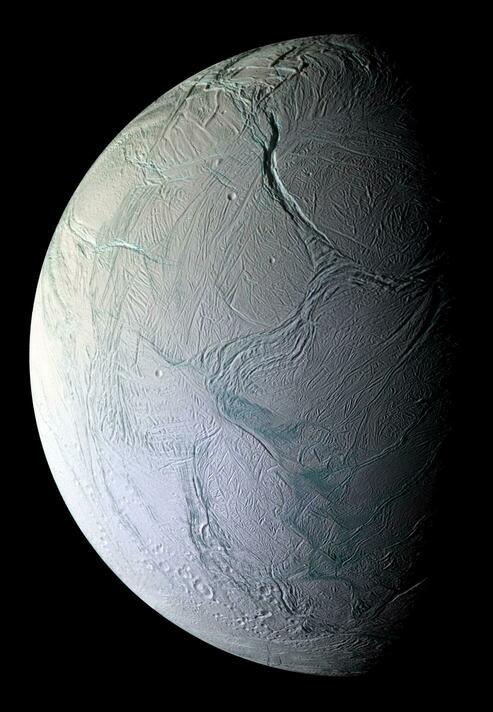Will Enceladus finally answer, ‘Are we alone?’
By Laurence Tognetti
We recently examined how and why the planet Mars could answer the longstanding question: Are we alone? There is evidence to suggest that it was once a much warmer and wetter world thanks to countless spacecraft, landers, and rovers having explored—and currently exploring—its atmosphere, surface, and interior. Here, we will examine another one of Saturn’s 83 moons, an icy world that spews geysers of water ice from giant fissures near its south pole, which is strong evidence for an interior ocean, and possibly life. Here, we will examine Enceladus.
In terms of space exploration, Enceladus was briefly visited by NASA’s Voyager 1 and Voyager 2 in 1980 and 1981, respectively, and wasn’t visited again until NASA’s Cassini spacecraft explored the Saturn system, ultimately performing multiple flybys of this icy moon starting in 2005. It was these flybys that revealed Enceladus’ unique geology and composition.
“Enceladus has many of the ingredients we think are necessary for life: a liquid water ocean beneath an icy shell; an energy source (tidal heating); and nutrients (we’ve detected carbon compounds, which could be used as food),” said Dr. Francis Nimmo, who is a Professor in the Department of Earth & Planetary Sciences at the University of California, Santa Cruz. “In this respect it is not so different from other moons with subsurface oceans, like Europa. What makes Enceladus unique is that it’s giving us free samples of its ocean: there are geysers which jet water vapor and ice crystals into space, where we can scoop them up with a passing spacecraft and analyze them. So, Enceladus is a very good place to go and look for potential life, because we can *directly* sample material from the ocean.”

NASA’s Cassini spacecraft used its mass spectrometer to discover organic materials, water vapor, carbon dioxide, carbon monoxide, and a mixture of volatile gases within these geysers, which could indicate the presence of life. Not only do the active geysers indicate the presence of an internal ocean, but it’s also indicative of a source of energy within Enceladus.
“Enceladus has captivated the astrobiology community because it is the first icy ocean world for which we have strong evidence supporting its habitability,” said Dr. Christopher Glein, who is a Lead Scientist and geochemist at the Southwest Research Institute in Texas. “Data from the Cassini mission show that Enceladus has the three ingredients that are required for life as we know it. Those are liquid water, essential elements (including organic molecules), and a source of energy that can be harnessed by life. Recently, we found that the geochemistry of Enceladus’s ocean makes phosphate minerals unusually soluble there. This strongly suggests that phosphorus availability will not impede the prospects for life but should instead serve as an opportunity.”
With the Cassini mission ending in 2017, there are currently no active missions exploring the Saturn system, let alone Enceladus. However, there are several future missions currently under study which could help us further understand Enceladus and whether it can support life. This includes NASA’s Enceladus Orbilander, whose science goals include determining if Enceladus has life, how it has life, and also to locate a suitable landing site for a potential surface mission.
“Orbilander is designed to answer the question of whether there is life in the Enceladus ocean as unambiguously as possible,” said Dr. Nimmo. “Because we don’t know what form life would take, Orbilander uses several different techniques to look for the presence of life-like attributes. And because most of the material that comes out of the geysers ends up back on the surface, Orbilander will look in the “snow” on the surface for signs of life, as well as in material that goes into orbit around Enceladus. After Orbilander, we should have a very good idea of whether or not Enceladus is inhabited.”
While we wait for another spacecraft to re-visit Enceladus, scientists continue to pour over data from the Cassini mission to try and squeeze every last bit of science about Saturn’s icy moon. We know it has an ocean, which indicates the possibility for life, but what kinds of life could be thriving in its oceanic depths? How has it evolved, and is it similar to life on the Earth?
“Enceladus is perhaps the most puzzling of ocean worlds. It’s so small that it should not have an ocean, yet it does. After over a decade of study, we now have a better understanding of how powerful tidal forces keep the interior warm and make Enceladus geologically alive. Could those same forces also sustain biological activity?”
And with this, we wonder if Enceladus will finally answer, “Are we alone?”
As always, keep doing science & keep looking up!
Featured Image: Saturn’s moon, Enceladus, taken by NASA’s Cassini spacecraft on October 9, 2008, after it skimmed within 25 kilometers (15.6 miles) of the surface. (Credit: NASA/JPL/Space Science Institute)
The post Will Enceladus finally answer, ‘Are we alone?’ appeared first on Universe Today.

October 31, 2022 at 02:08AM
via Universe Today read more...

Post a Comment